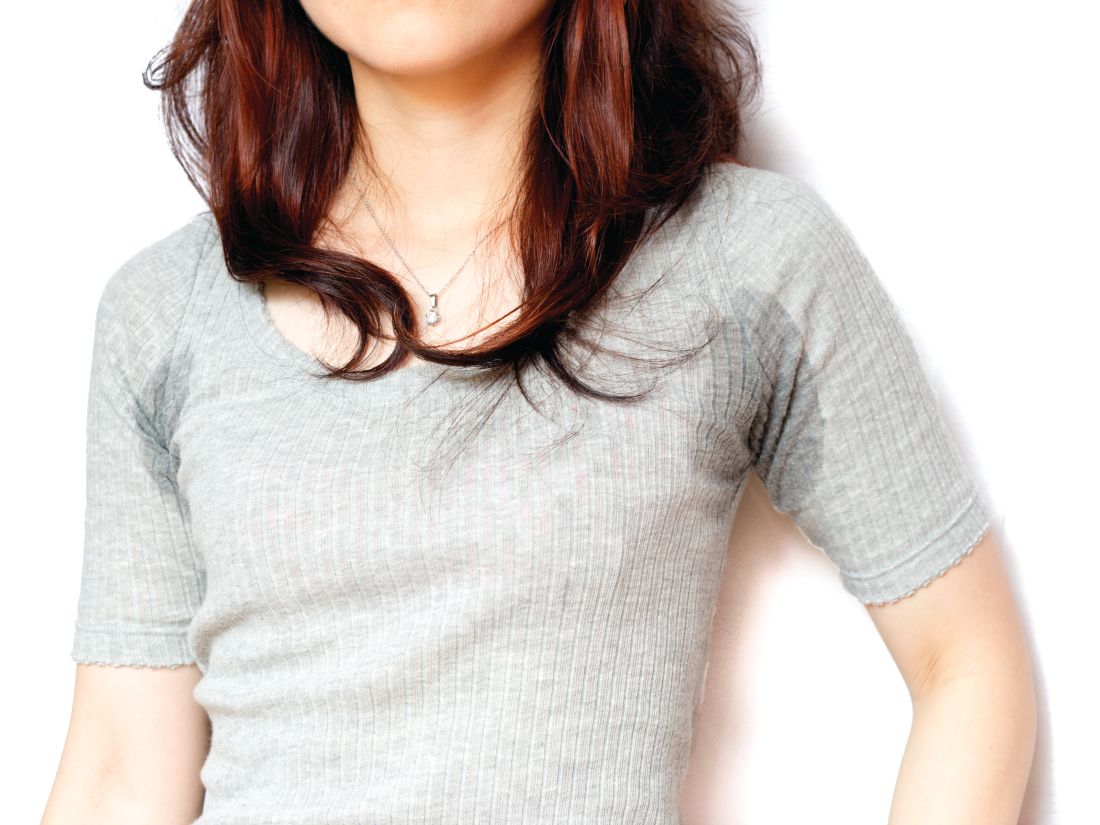User login
Hyperhidrosis – excessive sweating – is one of those diagnoses that make most physicians cringe because we know that the side effects of most of the common treatments are very limiting and patients continue to be frustrated. New treatments are emerging, and although oxybutynin is not Food and Drug Administration–approved for hyperhidrosis, it does show promise.
Primary hyperhidrosis is the excessive sweating from the axilla, palms, soles, or cranial-facial area. It is a clinical diagnosis that has been occurring for more than 6 months and meets at least four1 of the following criteria:
1. It occurs in eccrine dense areas (axilla, soles, palms or head).
2. It is bilateral and symmetrical.
3. It is absent nocturnally.
4. Its onset should be before age 25 years.
5. It occurs at least weekly.
6. There is a positive family history.
7. It impairs daily activities.
If signs of underlying disease are apparent – such as palpitations, night sweats, weight loss, unilateral symptoms, anxiety, or hypertension – further workup is needed to rule out disorders such as diabetes, hyperthyroidism, pheochromocytoma, or peripheral nerve injury.1
The pathophysiology of hyperhidrosis is not clearly understood. It is believed to be due to increased cholinergic stimulation given that there is no hypertrophy or hyperplasia of the sweat gland.2 Genetics appear to play a role as there is usually a family history of the disorder.2
Topical treatments are usually first line, starting with aluminum chloride antiperspirants, or anticholinergic creams such as glycopyrrolate or glycopyrronium. Unfortunately, many patients complain of the skin irritation so they discontinue their use.1
Botulinum toxin type A is a very safe and effective way of treating hyperhidrosis and is FDA approved for that purpose.3 Its drawbacks are that it is an injection (approximately 25 in each armpit), and it is very costly, usually $1,000-1,500 per session for both underarms. There are no major side effects, and reduction in sweating lasts for 4-12 months, with a median of 6 months.3
Oral treatment of hyperhidrosis, with medications such as glycopyrrolate and benztropine, has been reserved for second- or third-line treatment because of the unwanted side effects of dry mouth and drowsiness. But more recent studies are showing favorable outcomes with oxybutynin.1
Oxybutynin is well known and FDA approved for treatment of urinary frequency, incontinence, and enuresis. Recent studies have shown great success for use to control generalized hyperhidrosis. The mechanism of action is blocking the binding of acetylcholine and numerous other neurotransmitters.2
The literature does not give clear-cut dosing because it is not approved for hyperhidrosis, but gradually increasing doses starting at 2.5 mg daily for a week, then increasing to twice daily for 2 weeks, and then to 5 mg twice daily as a continued dose appears to be the most effective regimen with few side effects. The dosage can be increased, but increased side effects are noted with doses reaching 15 mg/day.1,2
Oxybutynin is not FDA approved for the treatment of hyperhidrosis, but it is an inexpensive drug, which makes it a viable option for use off label given all of the current research with positive outcomes.
It should be noted that if patients have any urinary retention, gastric motility issues, or narrow angle glaucoma, oxybutynin is contraindicated.
More studies are on the horizon, but finally there is hope for hyperhidrosis.
Dr. Pearce is a pediatrician in Frankfort, Ill. She said she had no relevant financial disclosures. Email her at [email protected].
References
1. Skin Appendage Disord. 2015 Mar;1(1):6-13.
2. An Bras Dermatol. 2017 Mar-Apr;92(2):217-20.
3. ISRN Dermatol. 2012. doi: 10.5402/2012/702714.
Hyperhidrosis – excessive sweating – is one of those diagnoses that make most physicians cringe because we know that the side effects of most of the common treatments are very limiting and patients continue to be frustrated. New treatments are emerging, and although oxybutynin is not Food and Drug Administration–approved for hyperhidrosis, it does show promise.
Primary hyperhidrosis is the excessive sweating from the axilla, palms, soles, or cranial-facial area. It is a clinical diagnosis that has been occurring for more than 6 months and meets at least four1 of the following criteria:
1. It occurs in eccrine dense areas (axilla, soles, palms or head).
2. It is bilateral and symmetrical.
3. It is absent nocturnally.
4. Its onset should be before age 25 years.
5. It occurs at least weekly.
6. There is a positive family history.
7. It impairs daily activities.
If signs of underlying disease are apparent – such as palpitations, night sweats, weight loss, unilateral symptoms, anxiety, or hypertension – further workup is needed to rule out disorders such as diabetes, hyperthyroidism, pheochromocytoma, or peripheral nerve injury.1
The pathophysiology of hyperhidrosis is not clearly understood. It is believed to be due to increased cholinergic stimulation given that there is no hypertrophy or hyperplasia of the sweat gland.2 Genetics appear to play a role as there is usually a family history of the disorder.2
Topical treatments are usually first line, starting with aluminum chloride antiperspirants, or anticholinergic creams such as glycopyrrolate or glycopyrronium. Unfortunately, many patients complain of the skin irritation so they discontinue their use.1
Botulinum toxin type A is a very safe and effective way of treating hyperhidrosis and is FDA approved for that purpose.3 Its drawbacks are that it is an injection (approximately 25 in each armpit), and it is very costly, usually $1,000-1,500 per session for both underarms. There are no major side effects, and reduction in sweating lasts for 4-12 months, with a median of 6 months.3
Oral treatment of hyperhidrosis, with medications such as glycopyrrolate and benztropine, has been reserved for second- or third-line treatment because of the unwanted side effects of dry mouth and drowsiness. But more recent studies are showing favorable outcomes with oxybutynin.1
Oxybutynin is well known and FDA approved for treatment of urinary frequency, incontinence, and enuresis. Recent studies have shown great success for use to control generalized hyperhidrosis. The mechanism of action is blocking the binding of acetylcholine and numerous other neurotransmitters.2
The literature does not give clear-cut dosing because it is not approved for hyperhidrosis, but gradually increasing doses starting at 2.5 mg daily for a week, then increasing to twice daily for 2 weeks, and then to 5 mg twice daily as a continued dose appears to be the most effective regimen with few side effects. The dosage can be increased, but increased side effects are noted with doses reaching 15 mg/day.1,2
Oxybutynin is not FDA approved for the treatment of hyperhidrosis, but it is an inexpensive drug, which makes it a viable option for use off label given all of the current research with positive outcomes.
It should be noted that if patients have any urinary retention, gastric motility issues, or narrow angle glaucoma, oxybutynin is contraindicated.
More studies are on the horizon, but finally there is hope for hyperhidrosis.
Dr. Pearce is a pediatrician in Frankfort, Ill. She said she had no relevant financial disclosures. Email her at [email protected].
References
1. Skin Appendage Disord. 2015 Mar;1(1):6-13.
2. An Bras Dermatol. 2017 Mar-Apr;92(2):217-20.
3. ISRN Dermatol. 2012. doi: 10.5402/2012/702714.
Hyperhidrosis – excessive sweating – is one of those diagnoses that make most physicians cringe because we know that the side effects of most of the common treatments are very limiting and patients continue to be frustrated. New treatments are emerging, and although oxybutynin is not Food and Drug Administration–approved for hyperhidrosis, it does show promise.
Primary hyperhidrosis is the excessive sweating from the axilla, palms, soles, or cranial-facial area. It is a clinical diagnosis that has been occurring for more than 6 months and meets at least four1 of the following criteria:
1. It occurs in eccrine dense areas (axilla, soles, palms or head).
2. It is bilateral and symmetrical.
3. It is absent nocturnally.
4. Its onset should be before age 25 years.
5. It occurs at least weekly.
6. There is a positive family history.
7. It impairs daily activities.
If signs of underlying disease are apparent – such as palpitations, night sweats, weight loss, unilateral symptoms, anxiety, or hypertension – further workup is needed to rule out disorders such as diabetes, hyperthyroidism, pheochromocytoma, or peripheral nerve injury.1
The pathophysiology of hyperhidrosis is not clearly understood. It is believed to be due to increased cholinergic stimulation given that there is no hypertrophy or hyperplasia of the sweat gland.2 Genetics appear to play a role as there is usually a family history of the disorder.2
Topical treatments are usually first line, starting with aluminum chloride antiperspirants, or anticholinergic creams such as glycopyrrolate or glycopyrronium. Unfortunately, many patients complain of the skin irritation so they discontinue their use.1
Botulinum toxin type A is a very safe and effective way of treating hyperhidrosis and is FDA approved for that purpose.3 Its drawbacks are that it is an injection (approximately 25 in each armpit), and it is very costly, usually $1,000-1,500 per session for both underarms. There are no major side effects, and reduction in sweating lasts for 4-12 months, with a median of 6 months.3
Oral treatment of hyperhidrosis, with medications such as glycopyrrolate and benztropine, has been reserved for second- or third-line treatment because of the unwanted side effects of dry mouth and drowsiness. But more recent studies are showing favorable outcomes with oxybutynin.1
Oxybutynin is well known and FDA approved for treatment of urinary frequency, incontinence, and enuresis. Recent studies have shown great success for use to control generalized hyperhidrosis. The mechanism of action is blocking the binding of acetylcholine and numerous other neurotransmitters.2
The literature does not give clear-cut dosing because it is not approved for hyperhidrosis, but gradually increasing doses starting at 2.5 mg daily for a week, then increasing to twice daily for 2 weeks, and then to 5 mg twice daily as a continued dose appears to be the most effective regimen with few side effects. The dosage can be increased, but increased side effects are noted with doses reaching 15 mg/day.1,2
Oxybutynin is not FDA approved for the treatment of hyperhidrosis, but it is an inexpensive drug, which makes it a viable option for use off label given all of the current research with positive outcomes.
It should be noted that if patients have any urinary retention, gastric motility issues, or narrow angle glaucoma, oxybutynin is contraindicated.
More studies are on the horizon, but finally there is hope for hyperhidrosis.
Dr. Pearce is a pediatrician in Frankfort, Ill. She said she had no relevant financial disclosures. Email her at [email protected].
References
1. Skin Appendage Disord. 2015 Mar;1(1):6-13.
2. An Bras Dermatol. 2017 Mar-Apr;92(2):217-20.
3. ISRN Dermatol. 2012. doi: 10.5402/2012/702714.


